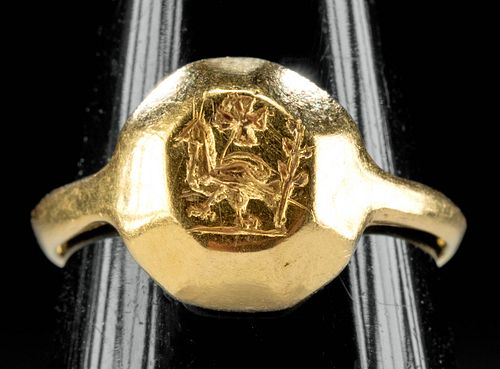5th C. Byzantine 21K+ Gold Ring Bird Insignia
About Seller
686 S Taylor Ave, Ste 106
Louisville, CO 80027
United States
Selling antiquities, ancient and ethnographic art online since 1993, Artemis Gallery specializes in Classical Antiquities (Egyptian, Greek, Roman, Near Eastern), Asian, Pre-Columbian, African / Tribal / Oceanographic art. Our extensive inventory includes pottery, stone, metal, wood, glass and textil...Read more
Two ways to bid:
- Leave a max absentee bid and the platform will bid on your behalf up to your maximum bid during the live auction.
- Bid live during the auction and your bids will be submitted real-time to the auctioneer.
Bid Increments
| Price | Bid Increment |
|---|---|
| $0 | $25 |
| $300 | $50 |
| $1,000 | $100 |
| $2,000 | $250 |
| $5,000 | $500 |
| $10,000 | $1,000 |
| $20,000 | $2,500 |
| $50,000 | $5,000 |
| $100,000 | $10,000 |
| $200,000 | $20,000 |
About Auction
Nov 10, 2022
Museum-worthy examples of classical antiquities (Egyptian, Greek, Roman, Near Eastern), Viking, Far East / Asian, Pre-Columbian, African / Tribal, Oceanic, Native American, Spanish Colonial, Nautical, Fossils, Ancient Jewelry, Fine / Visual Arts, so much more! Artemis Fine Arts info@artemisfinearts.com
- Lot Description
Near East, Byzantine Period, ca. 5th century CE. A stunning gold ring comprised of a slender band and a sizeable, hexagonal bezel, skillfully incised with a detailed insignia. Projecting outward as though to form a halo-like frame from the lustrous shine of the gold, the lovely insignia features the image of a Byzantine cross above a left-facing bird carrying an olive branch - a common Early Christian symbol of deliverance, intended to represent a scene from the story of Noah's Ark in the Book of Genesis in which a bird that returns to the Ark with an olive branch indicating that land was near and thus symbolizing that Noah and his family would be rescued from the flood. Size: 0.9" Diameter (2.3 cm); gold quality: 89.3% (equivalent to over 21 karats); weight: 5.6 grams; US ring size: 6
Rings were of particularly high importance in the Byzantine era. Gary Vikan in "Early Christian and Byzantine Rings in the Zucker Family Collection" notes, "No article of personal adornment was more prevalent in Byzantine society nor more important to the conduct of an individual's private and public business than was a signet ring. The emperor wore an official ring as a symbol of power and as an implement for the authentication of certain communications and documents, and the same was true for a wide range of civil and ecclesiastical officials. As for the average citizen, signets in their locking capacity were essential for the maintenance of personal security, whereas signets in their authenticating capacity were required by law for the validation of wills and testaments. Beyond this, rings functioned in a purely social context as jewelry - as a natural and traditional mode of self adornment" (The Journal of the Walters Art Gallery 45, 1987: page 32). In the fourth century, Christian imagery as a subject for insignia rings rose in popularity as a response to Constantine's legitimation and growing dominance of the faith, especially in the western Roman Empire. Thus, Christian symbols of deliverance became increasingly fashionable motifs to sport on one's fingers and often morphed from previously neutral images, just as the formerly conventional motif of a bird changed into the bird and olive branch of the Old Testament that we see here.
Provenance: private Boynton Beach, Florida Collection, USA; ex-private London, UK collection, assembled prior to 2000; ex-Virginia, USA collection
All items legal to buy/sell under U.S. Statute covering cultural patrimony Code 2600, CHAPTER 14, and are guaranteed to be as described or your money back.
A Certificate of Authenticity will accompany all winning bids.
We ship worldwide and handle all shipping in-house for your convenience.
#168987Expected light scratches, commensurate with age and wear. Otherwise, intact and excellent with impressive remaining detail.Condition
- Shipping Info
-
Artemis Gallery will no longer be able to offer in-house shipping for most international orders, as well as all oversized orders, including most paintings. These items are clearly marked in the listing as “3rd Party Shipping Required” in the listing. We have a list of recommended third party shippers to assist you in shipping to and from, and would be happy to assist you in working with them. We require a written authorization from the client to release property to any third party. You may fax a Shipping Release Form to 303-828-3235 or email your authorization to kristen@artemisgallery.com. Please note the all property must be removed from our premises within seven (7) business days following the last day of the auction.
-
- Buyer's Premium



 EUR
EUR CAD
CAD AUD
AUD GBP
GBP MXN
MXN HKD
HKD CNY
CNY MYR
MYR SEK
SEK SGD
SGD CHF
CHF THB
THB













